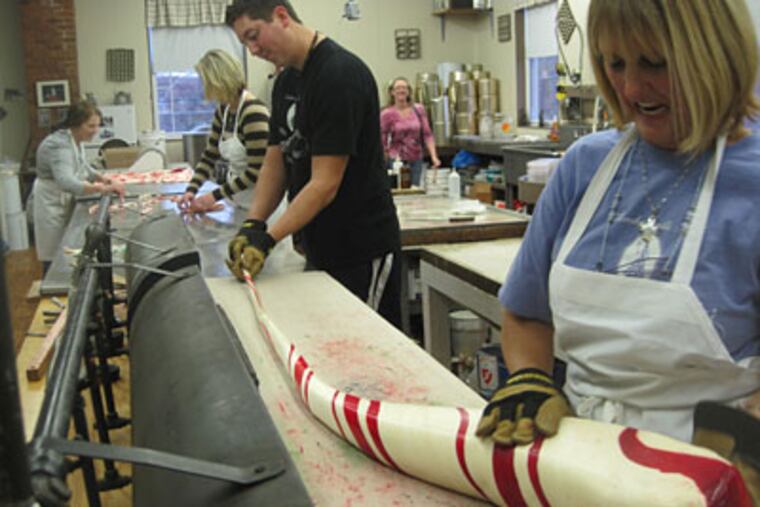Handmade candy canes: Miracles in red and white
The handcrafted candy cane can be an unforgiving thing. Boil the sugar syrup too hot (or low) or long, and you've got an unholy mess.

The handcrafted candy cane can be an unforgiving thing. Boil the sugar syrup too hot (or low) or long, and you've got an unholy mess.
Forget the cream of tartar, and you've got grainy crystals, a version of which you'll want later, but, whoa!, not at first.
You've got to knead in the oil of peppermint (or wintergreen or whatever) until it's well dispersed, a process started by poking a thumb in the doughy blob, then pouring the flavoring in.
The red stripes? You've got to flatten out some of the firming candy until it looks like a rasher of cherry bacon, and keep flipping it so it doesn't get brittle. You've got to twist the ropy lava just right; keep rolling the sticks so they don't sag and flatten on their bottoms.
And there's the rain. Humidity is the enemy of sugar candy; turns it sticky, dulls the sheen, makes it hard to package, as any maker of hard candy or clear toys or canes is quick to tell you.
All of which led Penny Oakford Trost to question why she was once again about the task on the second floor at Aunt Charlotte's Candies in Merchantville last Sunday, a drizzle falling outside the window: "I don't know quite why we still do it," she said. "Maybe because customers come in and say they saw us do it, or my parents do it, for Christmas back when they were kids."
She is the third generation of her family (Aunt Charlotte's was founded almost a century ago by Charles Brooks Oakford, who indeed had an Aunt Charlotte) making boxed chocolates and handmade nonpareils (the molten chocolate dotted from a handheld funnel onto a bed of sugar beads), and selling ribbon candy and almond bark and all manner of old-fashioned candy in the big, glittering retail shop on the first floor.
And, of course, there's the complement of from-scratch canes, which since the advent of automated cane-making machinery in the 1950s are as rare these days, as, well, a white Christmas.
The heavy-lifting part has fallen now to Penny's son, Ryan, a tall, beefy fellow dressed this afternoon in baggy black shorts.
Outside the day was cooling. But sugar candy prefers tropical (if not moist) temperatures: The sugar itself is boiled in a copper pot of water at about 320 degrees for 30 minutes, then turned out in an amber-colored, pliable blob on a worktable.
Ryan reminds his mother that this is why he's in shorts: It's warm.
He adds the flavor. Then lugs the mass over to the large hook on the wall, heaves it over the hook, and pulls it like taffy time and time again until the slabs of stuff magically begin turning silky white, their innards getting crystalline, their sides developing shiny fluting.
Penny has called downstairs. If there are any youngsters down there or families or old-timers who want to see the miracle of sugar dough transformed into candy canes - in this case 300 of them - they'd best get up there: There is a window for candy cane-making; it's open for about an hour or so.
Penny and Ryan shape the slightly stiffening blob into a big, buttery loaf on a canvas-covered table backed by an ancient space heater (made by Thomas Mills, the venerable Philadelphia manufacturer of candy-making tools), its face a wall of soft, blue flame.
You want to keep the dough warm and workable. Beside the flame, Penny has been slicing straps of a second, red-colored blob that she smoothes with a long meat-slicing knife and flips over and over again to keep flexible.
She applies the straps to the loaf like leather belts on an old steamer trunk. Now Ryan, in work gloves, grabs a corner of the loaf and pulls it into a long snake, rolling and twisting it on the table until the red straps become familiar red stripes. He chops off lengths of the rope.
Carol Black, a longtime worker, and Penny's daughter Cara gently curve the tops into a crook, tucking the sharp end back like a beak, a signature Aunt Charlotte's move.
In minutes, dozens are lined up to slip into clear sleeves, which has become more urgent: It is drizzling outside and the candy-cane window - like the season's itself - is closing fast.
Aunt Charlotte's Candies
5 W. Maple Ave.
Merchantville
856-662-0058
www.auntcharlottescandy.com
EndText